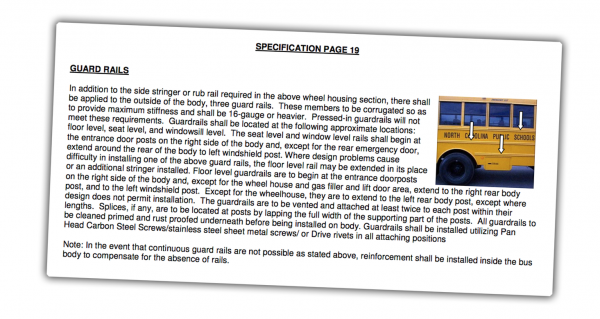They look a bit like bumpers, generally painted black against the bright yellow of a conventional American school bus; but they are more than a simple aesthetic choice, or a modest safety measure in case of a collision. These raised “rub rails” have a slightly bigger story to tell.
One neat, less-obvious feature of these rails is that they correspond to key structural points on the other side of the thin metal body of the vehicle. Running horizontally, they match up with the bottom, middle and top of a bus’s interior seating, helping stabilize rows of seats.
This turns out to be useful in multiple ways in case of a crash — aside from helping to distribute impact loads, this color-coded system aids emergency workers in assessing collision-damaged areas and determining (in severe situations) where to cut into the sides of a bus.

As Jason Torchinsky notes in an article for Jalopnik, regulations around these vary from state to state — in his own home state of North Carolina (pictured above), for example, he found certain regionally specific requirements for gauge and corrugation (shown above).
Then, too, there is a more obvious function: these raised areas help protect buses even in minor incidents, like side scrapes. If a driver takes a turn too tightly and brushes up against a post, the guardrails can minimize damage to the main vehicle. And while black is not standard everywhere, it contrasts well with the bright yellow, making buses stand out, much like bees with their alternating stripes.
When a bus gets hit hard enough, though, the sheer weight and solidity of these huge vehicles goes a long way toward reducing damage and injuries. Even without seatbelts, school buses are remarkably safe to ride in, especially compared to the mixed bag of smaller vehicles once used to help children get to and from school year in and year out.




Comments (3)
Share
I’m slightly confused about the “floor, seat, top of the seat” assertion since in the photos and videos you can see the top of the seats about halfway up the windows. Is it perhaps the top anchor point for the seats rather than the seats themselves? Or is it just the windowsill line, as specified in the North Carolina example, and the top of the seats are irrelevant?
Snopes disagrees with the placement of the black lines. They don’t necessarily show the floor, bottom of the seats, and top of the seats.
https://www.snopes.com/fact-check/black-lines-on-school-bus/
And by the way [email protected] is a valid email address. Stop trying to verify email domains. It’s people like you that require me to have a “backup” address. 😡
Some great info on school buses there, especially about the side railings